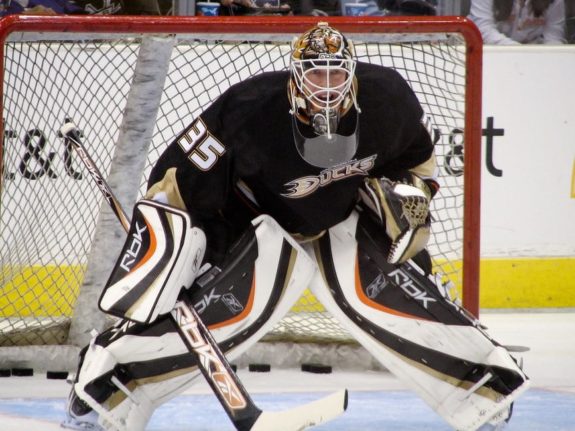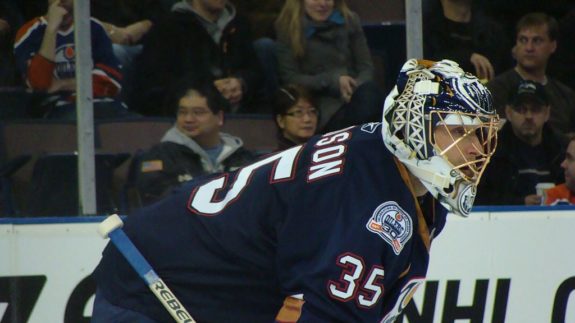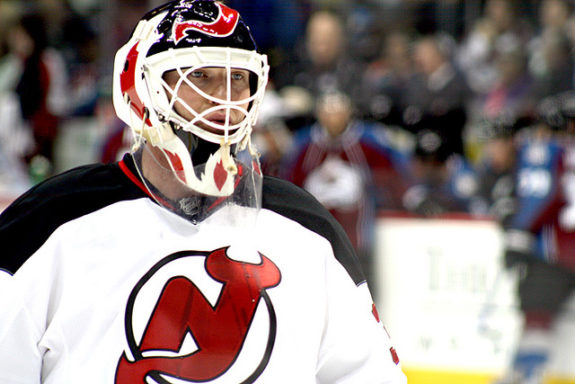They say hindsight is 20/20. So, I’m quite positive every single NHL general manager looks back wistfully at former players who simply couldn’t cut the mustard on his team but then found stardom playing for another franchise. Of all positions, it’s no secret that goaltenders are the most difficult to evaluate and develop.
Their progression into full-time professionals can take twice as long as skaters and even then, there is no guarantee of success. That’s why it’s no surprise the Calgary Flames have punted multiple notable netminders who flamed out in cowtown, only to find success elsewhere.
Former Flame Jean-Sebastien Giguere Became a Stanley Cup MVP in Anaheim
If you blinked, you might have missed Jean-Sébastien Giguère‘s short stint with the Flames. The product of Montreal, Quebec arrived in Calgary in 1997 via a trade with the Carolina Hurricanes and actually spent three seasons in the organization. However, he only found his way into 22 NHL games, going 7-10-2 with a lackluster 3.07 goals-against average (GAA) and a .902 save percentage (SV%).
Related: Flames Taking a Chance on Unproven Vladar as Markstrom’s Backup
Giguère was originally drafted by the Hartford Whalers 13th overall in the 1995 entry draft and was considered a top goaltending prospect. However, over three years, his combined numbers in the NHL and American Hockey League (AHL) simply weren’t good enough for the Flames, so they traded him to the Mighty Ducks of Anaheim during the 2000 offseason in exchange for a second-round pick. Looking back, former Calgary general manager Craig Button probably would have liked to give the lanky “Jiggy” just one more chance.

Once he arrived in sunny California, Giguère’s fortunes turned almost immediately. He suited up 34 times in his first campaign in Anaheim and by the 2001-02 season, he was the team’s starting netminder – a job he successfully held for the next seven years. While he put up some pretty impressive regular season numbers during his tenure with the Ducks, it was his otherworldly performance in the 2003 Stanley Cup Playoffs that made the former Flame a household name.
In an amazing run, Giguère went 15-6 while posting a 1.62 GAA and .945 SV%. While Anaheim fell short of winning the Stanley Cup, No. 35 still won the Conn Smythe Trophy, becoming only the fifth player in NHL history to secure the award without hoisting up the Cup. But, let’s not feel too badly for “Jiggy,” as he eventually got his ring after he led the Ducks to the franchise’s first championship in 2007. After being traded to the Toronto Maple Leafs during the 2009-10 season, the French Canadian goaltender finished out his playing days with the Colorado Avalanche in 2014, recording a 262-216-75 record along with a 2.53 GAA and a .913 SV%. Not too shabby for a guy the Flames completely gave up on.
Dwayne Roloson Couldn’t Stick in Calgary But Led Edmonton to a Stanley Cup Final
While the highly touted Giguère was struggling to find a place in the Flames organization, the team was right in the middle of developing undrafted Dwayne Roloson in their farm system. After signing as a free agent and playing a couple of years for the AHL Saint John Flames, Roloson was called up to the big club during the 1996-97 campaign. For the next two seasons, “Roli the Goalie” put up decent numbers on a rebuilding Calgary team, going 19-30-9 with a 2.89 GAA. However, the Flames then decided to move on from the native of Simcoe, Ontario, in 1998, trading him to the Buffalo Sabres, where he backed up Dominik Hasek for two years.

Roloson could be the textbook definition of a late-bloomer, as he bounced around the hockey world for years before finally finding major success. After being picked up in the 2000 Columbus Blue Jackets expansion draft, “Roli” instead signed with the St. Louis Blues AHL farm team. That successful minor league stint led to an opportunity to rejoin the NHL with the Minnesota Wild in 2001 and that’s when his career really took off.
Related: Flames’ Goaltending Stable for First Time in Decades
At age 34, Roloson not only appeared in his first NHL All-Star Game, but he also recorded the best SV% in the league during the 2003-04 campaign. After another successful season in Minnesota, No. 35 was traded in March 2006 to Calgary’s arch-rival, the Edmonton Oilers, in exchange for a first-round draft pick. Ironically, it was in Oil country where the former Flame really made a name for himself as the starting goaltender during the Oiler’s Cinderella 2006 Stanley Cup run.
Roloson posted a sensational record of 12–5 through the first three rounds and was considered a front-runner for the Conn Smythe Trophy if the Oilers were victorious in the final. Unfortunately, during Game 1 against the Carolina Hurricanes, the team’s playoff MVP suffered a third-degree MCL sprain on his right knee and was knocked out of the series. Edmonton would ultimately lose the series in seven games, but Roloson had established himself as the franchise’s number one netminder and went on to play three more seasons in Oil country.
In the summer of 2009, Roloson became an unrestricted free agent and chose to sign in New York to play for the Islanders, but he found himself on the move again just a couple of years later after being traded to the Tampa Bay Lightning. At the ripe old age of 42, the veteran goaltender finally hung up his skates in 2012. After playing 606 NHL games, he finished with a record of 227-257-82, a 2.72 GAA and a .908 SV%. While he was never a superstar, “Roli the Goalie” could have been a dependable puck stopper in Calgary for many years if the Flames had given him more of a chance.
The Flames Passed on Drafting Hall of Famer Martin Brodeur
OK, I know this next one is a bit of a stretch. No, Martin Brodeur was never a Flame, but he most certainly could have been playing in front of the C of Red if team management had picked him in the 1990 NHL Entry Draft. Instead, the Flames brokered a deal with the New Jersey Devils to move up to the No.11 slot to select the draft’s highest-ranked goalie prospect, the Brandon Wheat Kings’ Trevor Kidd. Meanwhile, the Devils used their No. 20 selection to snag Brodeur, a lesser-known prospect from the Quebec Major Junior league.

Remember when I said hindsight is 20/20? Could you imagine if the Flames had been the ones who took a chance on the lower-ranked Brodeur? Talk about a franchise-altering move! Kidd was supposed to be the heir apparent to the Flames’ Stanley Cup-winning netminder Mike Vernon, and while he did eventually secure the number one goaltender job, he never found great success in Calgary and was traded out of cowtown in 1997. He ended up being somewhat of a journeyman NHLer with stops in Carolina, Florida and Toronto. The native of Dugald, Manitoba, was out of the big leagues by the end of the 2003-04 season and finished with a middling 140-162-52 record, a 2.84 GAA and a .901 SV% in 387 games played.
You May Also Like:
- Flames & Maple Leafs Trade History Revisited
- Calgary Flames’ 2024-25 Bounce Back Candidates
- Flames Will Be Elite Team When New Arena is Built
- NHL Rumors: Blue Jackets, Oilers, Flames, Senators
- Top Contenders for 2025 Calder Trophy
If we compare Kidd’s ode to mediocrity to the spectacular career of Brodeur, I’m quite sure the heads of every single Flames fan will start spinning until they eventually pop right off. I would need to write a completely separate article to fully document the long list of No. 30’s impressive accomplishments, so here’s a small sampling to give you an idea of why he was a first-ballot Hall of Famer and is in the conversation for being the greatest goalie of all time.
- Calder Trophy as Rookie of the Year
- Three Stanley Cups
- Four Vezina Trophies
- Nine NHL All-Star Game Appearances
- Most NHL games played by a goaltender – 1,266
- Most Regular Season Wins – 691
- Most Regular Season Shutouts – 125
- Most Career Saves – 28,508
I’m not even including his career playoff records, but I think you get the picture. Brodeur retired in 2015 after 21 stellar NHL seasons and finished with a 691-397-154 record, a 2.24 GAA and a .912 SV%. As I said before, projecting which goaltenders will hit and which will ultimately miss is an almost impossible task. But, it’s still a very interesting exercise to look back at who the Flames let go or didn’t even draft and wistfully wonder: “What if?”
